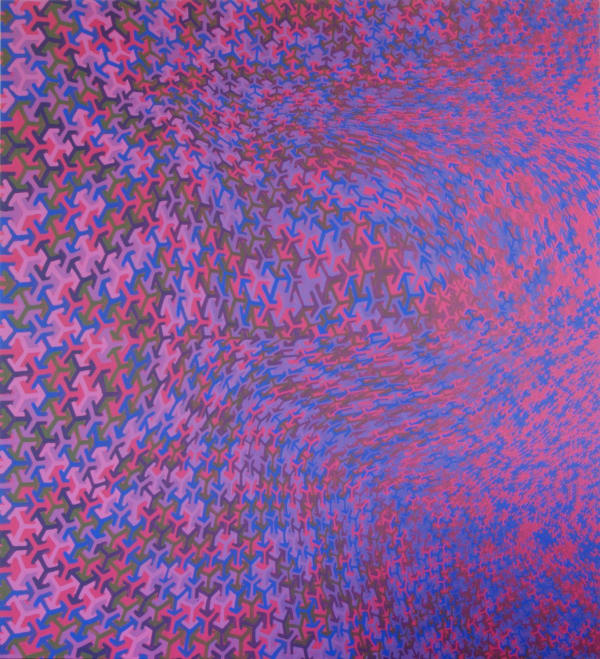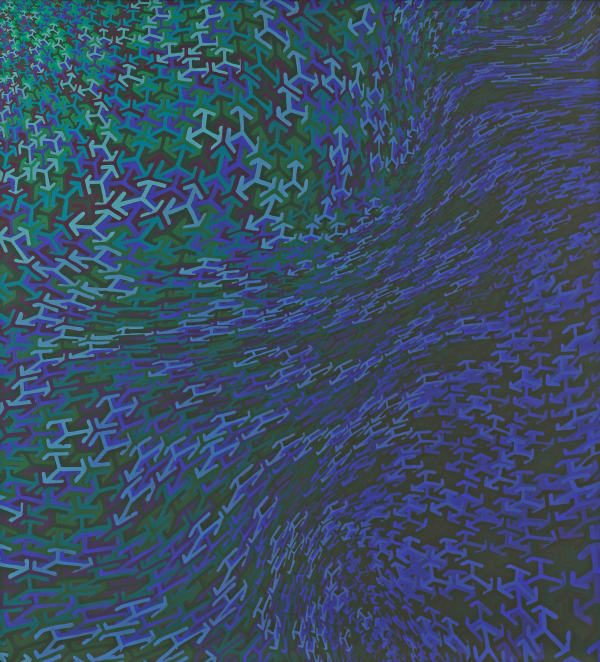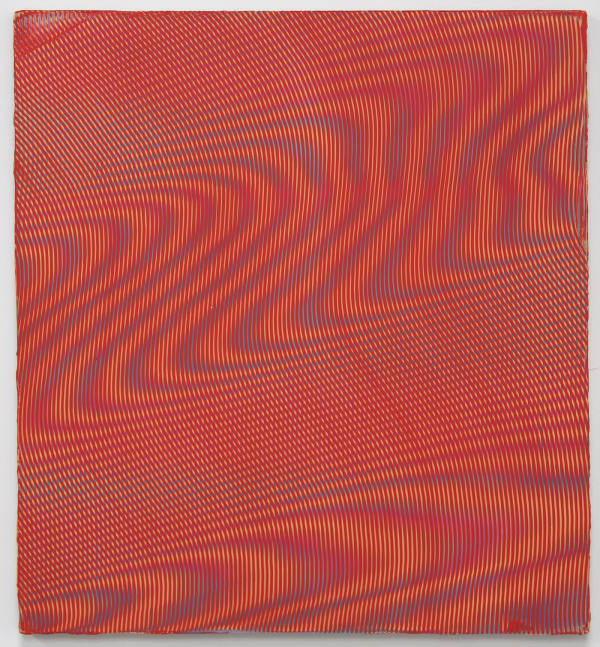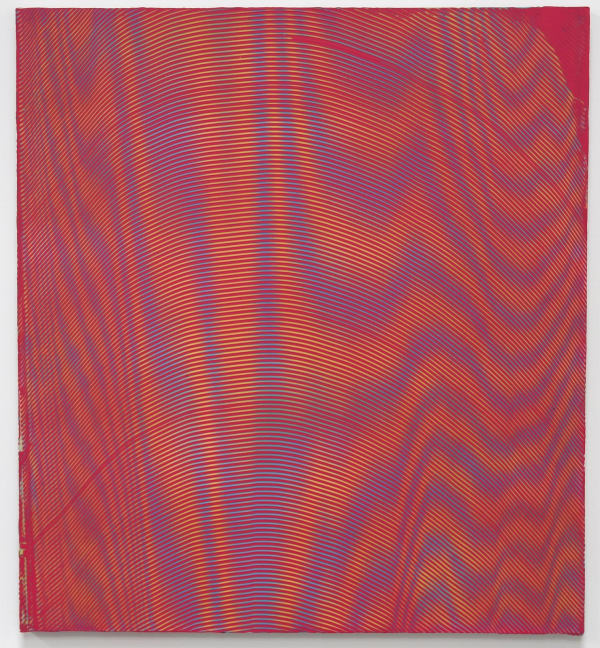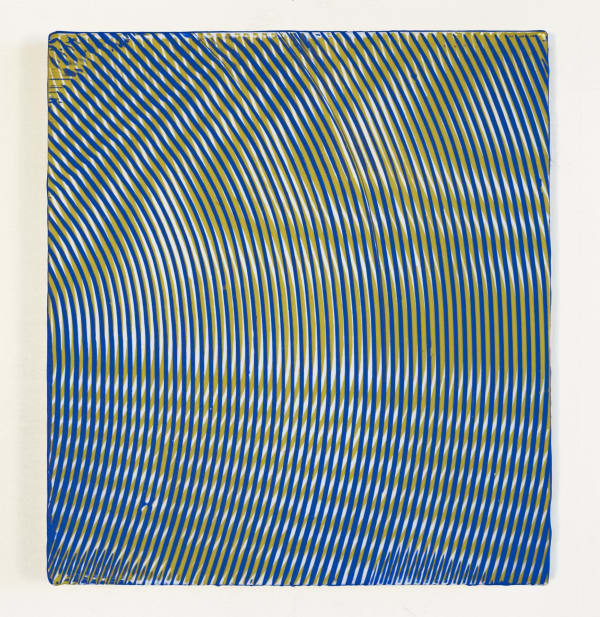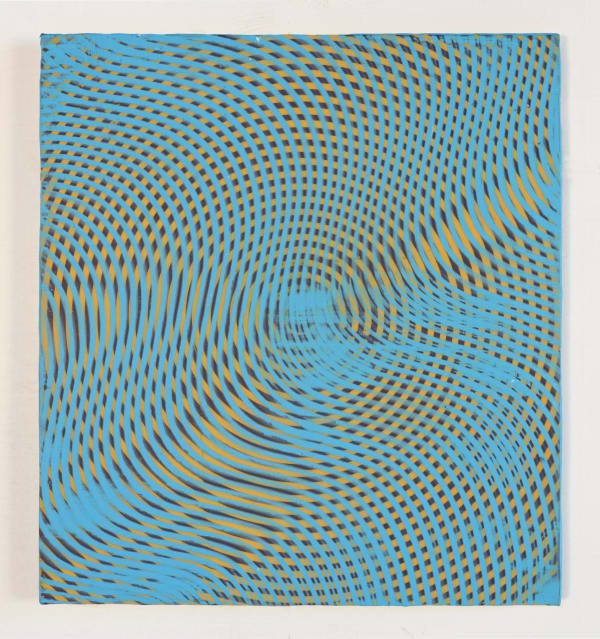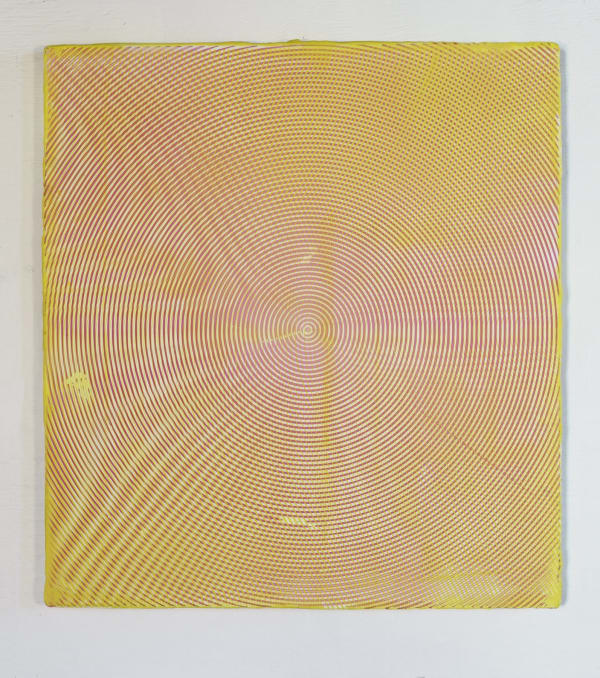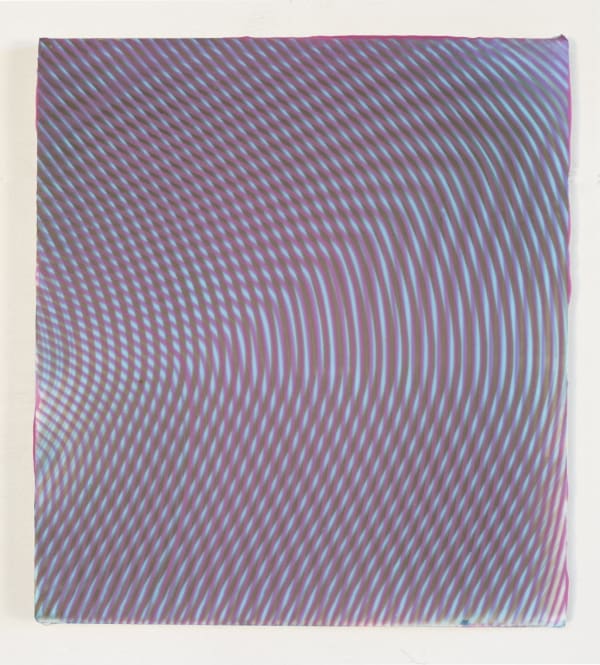Anoka Faruqee's early paintings are the product of an insistent practice of conceptual exploration. In a series of diptychs from 2002-2006, Faruqee first made a painting through spontaneous pouring or loose mixing of colors on canvas, then meticulously replicated it by analyzing complex color shifts and reproducing their effects through highly controlled mark- making. The gestural "original" and labor-intensive "copy" hang together as diptychs.
In the "Fade" paintings, begun in 2006, Faruqee mixed hundreds of subtly shifting colors to create luminous fading effects in which patterns seem to gradually disappear into the painting's ground color. The illusion looks like the result of a translucent airbrush or painterly spill. But in fact these works were created slowly and deliberately, one handmade "pixel" at a time.
The handmade "pixels" are tripod or asterisk forms derived from Islamic tile geometry, but painted freehand, without the use of rulers or grids. For Faruqee, who is second generation Bangladeshi-American with an Islamic heritage, using the tripod or asterisk form is not about cultural posturing.
In her words, "Because someone centuries ago spent a good amount of time playing with a ruler and a compass, I can lift from that tradition a kind of readymade handmade pixel. Those experiments were indeed the mathematical forerunners of current digital technology. I'm not interested in merely quoting or "describing" these forms, forever suspending them in their historical moment. I use them in the present tense for what they are and what they can become."
Faruqee paints her modular gestures on subtly increasing curves, starting only with a loose plan. Many decisions about the shape and direction of the curves happen during the act of painting. The paintings thus unfold in the making, revealing an unpredictable, paradoxical order. The "handmade pixels" become metaphors for a process that balances control and accident, mirroring both the systems of growth in nature and the undulating space of mathematical computer modeling.
In 2012 Faruqee embarked on a new direction in her work in collaboration with her husband, David Driscoll. These newer works can be seen on their joint page on our website here.
-

Look Both Ways
Banerjee, Campbell, Crotty, Danziger, DeFeo, Faruqee, Phungrasamee Fein, Haeckel, Hawkinson, Lukas, Maggi, O'Reilly, Ouadahi, Porter, Pwerle, Rath 8 Sep - 6 Oct 2012Hosfelt Gallery will inaugurate its new San Francisco venue with the group exhibition, Look Both Ways, opening at 260 Utah Street (at 16th Street) on September 8, 2012. Both a...Read more -

TIME FLIES
Jim Campbell, Julie W Chang, Anoka Faruqee, Andrea Higgins, Stefan Kürten, Michael Light, Crystal Liu, Marco Maggi, John O'Reilly, Liliana Porter, Gideon Rubin, John Andrews, Nelleke Beltjens, Jonathan Brand, Anthony Discenza, Alfredo Jar 9 Jul - 13 Aug 2011Celebrating the artists and exhibitions of the past 12 years at our San Francisco location, Time Flies explores permutations of the experience of time, including memory and nostalgia; disruptions and...Read more -

Anoka Faruqee
The Longest Day of the Year 7 Sep - 16 Oct 2010In her third solo exhibition at Hosfelt Gallery, Los Angeles-based Anoka Faruqee presents new paintings that are surprisingly freehand and subjective in nature, all the while maintaining the discipline and...Read more -

In Full Color
Campbell, Chang, Faruqee, Haeckel, Liu, Lukas, Ouadahi, Rodriguez, Andrews, Grubin, Houge, Kremer, Mayer, Stenger 9 Jan - 7 Mar 2010New York Gallery John Andrews, Jim Campbell, Julie Chang, Anoka Farquee, Joan Grubin, Jutta Haeckel, Christian Houge, Naomie Kremer, Crystal Liu, Emil Lukas, Gerhard Mayer, Driss Ouadahi, Lordy Rodriguez, Jeremy...Read more -

New Work
Campbell, Faruqee, Lukas, Ouadahi, Porter, Horn, Stenger 1 Jul - 1 Aug 2009New York Gallery NEW WORK: Timothy Horn, Jim Campbell, Liliana Porter, Driss Ouadahi, Anoka Faruqee, Jeremy Stenger, Emil Lukas, and others.Read more -

Anoka Faruqee
CMY RGB XYZ 22 Feb - 5 Apr 2008New York Gallery Anoka Faruqee’s exceptionally beautiful paintings are the product of an insistent practice of conceptual exploration. In one series of works, Faruqee has meticulously replicated paintings that have...Read more -

PATTERN VS. DECORATION
Chang, Danziger, Faruqee, Phungrasamee Fein, Haeckel, Higgins, Kürten, Liu, Ouadahi, Rodriguez, Adibi, Brand, Dopp, El Hanani, Grubin, Hackett, Hoferer, Mayer, Napangardi, Outlaw, Stenger, Wasson 12 Jul - 14 Aug 2007New York Gallery The “Pattern and Decoration” movement of the 1970s arose in response to the emergence of Minimalism and its strictures. It derived in part from Pop Art’s exuberant...Read more -

PATTERN VS. DECORATION
Chang, Danziger, Faruqee, Phungrasamee Fein, Haeckel, Higgins, Kürten, Liu, Ouadahi, Rodriguez, Adibi, Brand, Dopp, El Hanani, Grubin, Hackett, Hoferer, Mayer, Napangardi, Outlaw, Stenger, Wasson 16 Jun - 4 Aug 2007The “Pattern and Decoration” movement of the 1970s arose in response to the emergence of Minimalism and its strictures. It derived in part from Pop Art’s exuberant cultural mining and...Read more -

Anoka Faruqee
As Far As the Eye Can See 5 May - 9 Jun 2007Anoka Faruqee’s paintings are intensely colored and laboriously produced. Her process exploits the relationship between the spontaneous, authentic occurrence and the methodical construction. One segment of her work involves diptychs,...Read more -

HOSFELT GALLERY NEW YORK Preview
Campbell, Faruqee, Phungrasamee Fein, Higgins, Light, Liu, Maggi, Porter, Rubin, Andrews, Barnes, Beltjens, Chippendale, Dopp, Horn, Hsu, Kremer, Napangardi, Outlaw, Rose 18 Feb - 25 Mar 2006New York Gallery Hosfelt Gallery is pleased to present the inaugural exhibition in its new Hell’s Kitchen, Manhattan, venue. The exhibition spaces are designed around concepts of spatial flow and...Read more
-

I’d Rather Be Here and Now: The Performative Verb of Painting
Liena Vayzman, Xtra Contemporary Art Quarterly, April 1, 2013 -

Searching for meaning within in a forest of asterisks
Kenneth Baker, SF Chronicle, May 12, 2007 -

Anoka Faruqee and David Driscoll
Susan Snodgrass, Art in America, October 1, 2005 -

ANOKA FARUQEE
James Yood, ARTFORUM, February 1, 2001 -

Anoka Faruqee
John Brunetti, New Art Examiner, October 1, 2000

